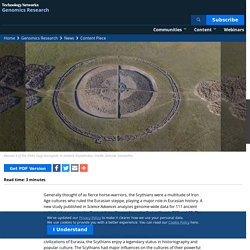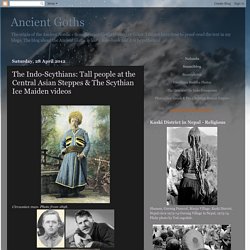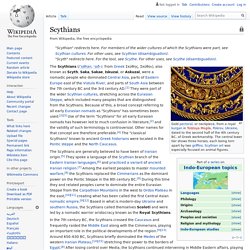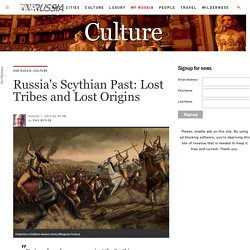

DNA Offers New Insights Into the The Origins and Decline of the Scythians. Generally thought of as fierce horse-warriors, the Scythians were a multitude of Iron Age cultures who ruled the Eurasian steppe, playing a major role in Eurasian history.

A new study published in Science Advances analyzes genome-wide data for 111 ancient individuals spanning the Central Asian Steppe from the first millennia BCE and CE. The Scythians. "What sort of men are these!?

" That question must have perplexed the Persian leader Darius when, in the midst of battle, he watched his Scythian enemies abandon the serious business of war in order to take off suddenly in chase of a hare they had spied. Well the same query persists in the minds of modern civilized men as scholarhsip adds to what we know about this strange custom of Eurasia's mounted nomad. New research and thousands of examined burial sites in the last 20 years in South Russia and the Altai have helped us to paint a much fuller picture of this vigorous nomad people with their unique animal art and love of the horse - an extraordinary race from whom the civilized world learned to wear trousers and riding horses.
The Indo-Scythians: Tall people at the Central Asian Steppes & The Scythian Ice Maiden videos. Two Khuvash men and ancient art of Scythians, 4th Century BCE.

To Chuvash menn og eldgammel skytisk kunst fra det fjerde århundret før vanlig tidsregning. The Scythian Steppe people were often blonde people and in general they were tall people. Many ancient mummies of the historical Scythians are found from Mongolia and west-wards. Ahmad Ibn Fadlan from Baghdad described the Scythians in the 10th century CE, when they were trading with the Volga Bolgars in the Russian areas.
Fadlan described their stature as tall "as date palm trees", with beautiful bodies, with blonde hair and with tattoos. Pot-smoking warriors who attached enemy bodyparts to their horses: Scythians reviewed. Scythians. A nomadic people of the Pontic steppe The Scythians (; from Greek Σκύθης, Σκύθοι), also known as Scyth, Saka, Sakae, Iskuzai, or Askuzai, were a nomadic people who dominated Central Asia, parts of Eastern Europe east of the Vistula River, and parts of South Asia between the 7th century BC and the 3rd century AD.[1] They were part of the wider Scythian cultures, stretching across the Eurasian Steppe, which included many peoples that are distinguished from the Scythians.

Because of this, a broad concept referring to all early Eurasian nomads as "Scythians" has sometimes been used.[2][3] Use of the term "Scythians" for all early Eurasian nomads has however led to much confusion in literature,[2] and the validity of such terminology is controversial. Russia's Scythian Past: Lost Tribes and Lost Origins. "No invader who comes against the Scythians can ever escape and none can catch them if they do not wish to be caught.“ – Herodotus We know relatively little of the legendary people known as the Scythians, but what we do know is largely derived from the father of history, Herodotus.

The great Greek thinker spoke authoritatively about these fascinating nomads, but archeologists are just now learning how a vast civilization suddenly appeared, and then as suddenly vanished. A recent expedition in Crimea, and an ongoing effort known as “Kyzyl – Kuragino” in Siberia, promise new insight into the warlike people who once ruled over much of Eurasia. The First Women Warriors on Horseback. Scythian women were kicking butt and taking names from the 7th century BC to the 2nd century AD.

Source: CAIS The Scythians migrated from central Asia to southern Russia, centering over the present day Crimean peninsula, in the 8th and 7th centuries BC. The tribe was artistic, violent, and comprised entirely of excellent horse riders. They were among the earliest people to master horseback riding, a tactical advantage that astonished and overwhelmed their neighbors. Every Scythian had at least one personal mount, but the wealthy owned vast herds. Ancient Worlds reports, “The most perfectly preserved horse found at Pazyryk is a 12-15 year old thoroughbred-type dun mare of about 13 hands high, which would be about average height for Scythian horses. Scythians utilized simple saddles consisting of felt, hair and leather. Source: State Hermitage Museum They also created elaborate head dresses for their horses.
But that’s not even the coolest part, folks. Source: Siberian Times Go Riding!